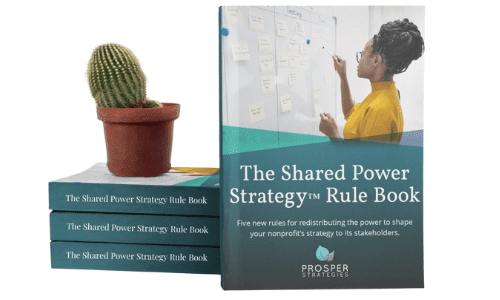This is it, the fifth and final rule in The Shared Power Strategy™ Rule Book. As I said last week, I think this is the most important rule of all.
Rule #5 is “we are ever-evolving.”
This is the rule that reminds us it’s not enough to capture input from our stakeholders once every three to five years when it comes time to develop our next strategic plan. Instead, we must find ways to encourage constant, ongoing feedback from the people and communities we serve, as well as our other stakeholders, like donors and funders. Then, we must be agile enough to respond.
[bctt tweet=”We must find ways to encourage constant, ongoing feedback from the people and communities we serve, as well as our other stakeholders, like donors and funders. Then, we must be agile enough to respond.” username=”ProsperStrat”]We can’t truly share the power to shape our organizations’ strategies with our stakeholders until we create an efficient feedback loop, where they have the power to tell us what’s working and what’s not in real time, and we make the commitment to evolve based on their input.
That sort of feedback loop is the whole point of the Shared Power Strategy™ philosophy. It’s what allows our organizations to truly work for and with their stakeholders. It’s what allows us to build more effective, equitable organizations.
See Rule #5 below, and then read on to learn what’s next as we transition from introducing this philosophy to helping your organization put it into action.
Rule 5: We Are EVER-EVOLVING
We seek ongoing input from our communities and continually hone our approach according to their feedback.
We recognize that strategy work is never really “done.” Neither is the process of seeking and responding to feedback from our stakeholders. Once we’ve put the finishing touches on our strategic plans (or fundraising, communications or program plans), the truly hard work begins.
This is when we must commit to measuring our work against the performance indicators our stakeholders have agreed upon. Then, we must begin regularly reporting the results not just to our donors and funders, but to everyone who affects and is affected by our work. And we must make it easy for them to give us real-time feedback.
It is ultimately up to our stakeholders, and most importantly to our beneficiaries, to determine whether what we’re doing is really working. And when they tell us it’s not, we know we cannot wait until we get to the end of our three or five-year strategic plan to do something about it. Instead, we must act immediately, refining or in some cases even pivoting our strategies to respond to their feedback.
It’s hard work to have a strategy that is continually evolving in response to what we learn from our stakeholders. But it is the only way we can ensure that the work we do every day is truly in the best interest of the people and communities we serve.
Is your organization ready to make Shared Power Strategy™ part of its DNA?
Making the leap won’t be easy.
The sector has been built around old rules and inequitable power structures that amplify the voices of boards and funders, while drowning out those of the people your organizations exist to serve.
But it’s absolutely essential. So what can you do to get started?
First, recycle that old rule book, the one that has kept your nonprofit’s thinking small, and its impact smaller. Then, start discussing and experimenting with these rules in your day-to-day work. In the coming weeks, we plan to release a variety of resources that will help you start to bring the Shared Power Strategy™ philosophy to life in meaningful, concrete ways. This includes a stakeholder mapping system, a stakeholder engagement toolkit, and templated surveys and focus group discussion guides you can use to involve your stakeholders in the strategic process.
True to the spirit of this philosophy, we look forward to continuing to shape the approaches that support Shared Power Strategy™ based on your input and feedback. We’d love to hear how these rules are working for your organization, and welcome your ideas about resources and tools we can create to help you bring them to life.
Download The Shared Power Strategy™ Rule Book
Within it are the five new rules that will transform the way your nonprofit approaches strategy, making the process more effective, inclusive and equitable.

